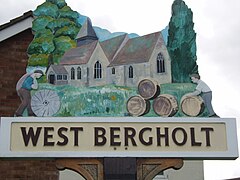West Bergholt
| West Bergholt | |
|---|---|
 |
|
| West Bergholt shown within Essex | |
| Population | 3,344 (2011) |
| OS grid reference | TL965270 |
| District | |
| Shire county | |
| Region | |
| Country | England |
| Sovereign state | United Kingdom |
| Post town | Colchester |
| Postcode district | CO6 |
| Dialling code | 01206 |
| Police | Essex |
| Fire | Essex |
| Ambulance | East of England |
| EU Parliament | East of England |
| UK Parliament | |
West Bergholt, formerly known as Bergholt Sackville, is a large rural village and civil parish in Essex, England, lying near the border with Suffolk, close to the ancient town of Colchester. With a history going back to medieval times the village is now part of the Colchester Borough Council seat of West Bergholt and Eight Ash Green. In 2008 the village won the Class 2 category, and was placed third overall in the RCCE Best Kept Village in Essex competition.
The village lies in and around a triangle formed by Colchester Road, Chapel Road and Lexden Road.
Around the village lie numerous farms and large areas of woodland, including Hillhouse Wood, always known locally as Bluebell Wood, which was purchased by the Woodland Trust with the help of local people. Many walks exist through the wood, and a migrant population of various breeds of deer can sometimes be seen.
Elmer's was the butchers shop. Digby's was the name of the general store, which is now the East of England Co-operative Society. Mr Digby's son drove a local bus service to Colchester.
Prehistoric, Iron-Age, and Roman material from West Bergholt Hall, St. Mary's church, and nearby sites suggest that the area may have been continuously settled. Scattered finds in the parish include several Palaeolithic axes from the heath, Iron-Age and Roman pottery and coins. There are large areas of undated cropmarks to the south of Hill House farm.
An archaeological dig carried out in 1977 found evidence of a Bronze Age cemetery just to the south of Chitts Hill Bridge. The dig found seven circular ditches, believed to be former central mounds, which contained cremation burials in urns, some upright. Ten cremations were found without urns and five were of children. Neolithic flints were discovered, representing scrapers, blades and cutting flakes. The pottery found dated the site to between 1500 and 1000 BCE.
The Normans reached the village in 1067, after their conquest of 1066. The village had already been named Bergholta by the Anglo-Saxons, meaning "wood on a hill" (the woodland in reference here is believed to be the modern Hillhouse Wood on the outskirts on the village). The village also already had a church, in the form of a wooden single-celled building on the site of the current "Old Church", although was one of the least populous parishes in Lexden Hundred in the Middle Ages. The combined total of free tenants, unfree tenants, and slaves was 27 in 1066 and probably 32 in 1086. In 1377 only 105 inhabitants paid the poll tax.
...
Wikipedia

